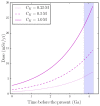On the Role of 40K in the Origin of Terrestrial Life
- PMID: 36295055
- PMCID: PMC9604808
- DOI: 10.3390/life12101620
On the Role of 40K in the Origin of Terrestrial Life
Abstract
The abundance and biological role of potassium suggest that its unstable nuclide was present in all stages of terrestrial biogenesis. With its enhanced isotopic ratio in the Archean eon, 40K may have contributed to the special, perhaps unique, biogenetic conditions that were present in the primitive Earth. Compared to the U and Th radionuclides, 40K has a less disruptive radiochemical impact, which may drive a moderate, but persistent evolution of the structural and functional properties of proto-biological molecules. In the main β-decay route of 40K, the radiation dose generated by an Archean solution with potassium ions can be larger than the present background radiation on Earth by one to two orders of magnitude. Estimates of the rates of organic molecules indirectly affected by β decays are provided for two schematic models of the propagation of secondary events in the solvent of prebiotic solutions. The left-handed β- particles emitted by 40K are the best candidates to trigger an enantiomeric excess of L-type amino acids via weak nuclear forces in the primitive Earth. The concentration-dependent radiation dose of 40K fits well in dry-wet scenarios of life's origins and should be considered in realistic simulations of prebiotic chemical pathways.
Keywords: molecular chirality; origins of life; potassium; radiation chemistry.
Conflict of interest statement
The author declares no conflict of interest.
Figures


Similar articles
-
On the origins of life's homochirality: Inducing enantiomeric excess with spin-polarized electrons.Proc Natl Acad Sci U S A. 2022 Jul 12;119(28):e2204765119. doi: 10.1073/pnas.2204765119. Epub 2022 Jul 5. Proc Natl Acad Sci U S A. 2022. PMID: 35787048 Free PMC article.
-
Life's Biological Chemistry: A Destiny or Destination Starting from Prebiotic Chemistry?Chemistry. 2018 Nov 13;24(63):16708-16715. doi: 10.1002/chem.201801847. Epub 2018 Aug 13. Chemistry. 2018. PMID: 29870593 Review.
-
On the origin of molecular "handedness" in living systems.J Mol Evol. 1975 Oct 29;6(2):91-8. doi: 10.1007/BF01732290. J Mol Evol. 1975. PMID: 1202234
-
Mimicking the surface and prebiotic chemistry of early Earth using flow chemistry.Nat Commun. 2018 May 8;9(1):1821. doi: 10.1038/s41467-018-04147-2. Nat Commun. 2018. PMID: 29739945 Free PMC article.
-
Chemical markers of prebiotic chemistry in hydrothermal systems.Orig Life Evol Biosph. 1992;22(1-4):109-34, 191-242. doi: 10.1007/BF01808020. Orig Life Evol Biosph. 1992. PMID: 11537550 Review.
Cited by
-
Special Issue: 'Advances in Space Biology'.Life (Basel). 2024 Jul 25;14(8):931. doi: 10.3390/life14080931. Life (Basel). 2024. PMID: 39202673 Free PMC article.
-
Origin of the RNA World in Cold Hadean Geothermal Fields Enriched in Zinc and Potassium: Abiogenesis as a Positive Fallout from the Moon-Forming Impact?Life (Basel). 2025 Mar 4;15(3):399. doi: 10.3390/life15030399. Life (Basel). 2025. PMID: 40141744 Free PMC article.
References
-
- Oparin A.I. Proiskhozhdenje Zhisni. Moskowski Rabochii; Moscow, Russia: 1924.
-
- Luisi P.L. The Emergence of Life From Chemical Origins to Synthetic Biology. Cambridge University Press; Cambridge, UK: 2016.
Grants and funding
LinkOut - more resources
Full Text Sources

